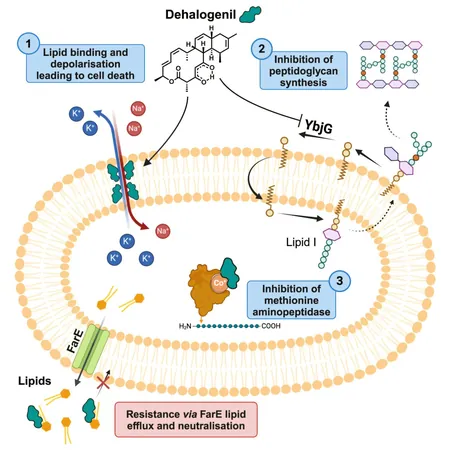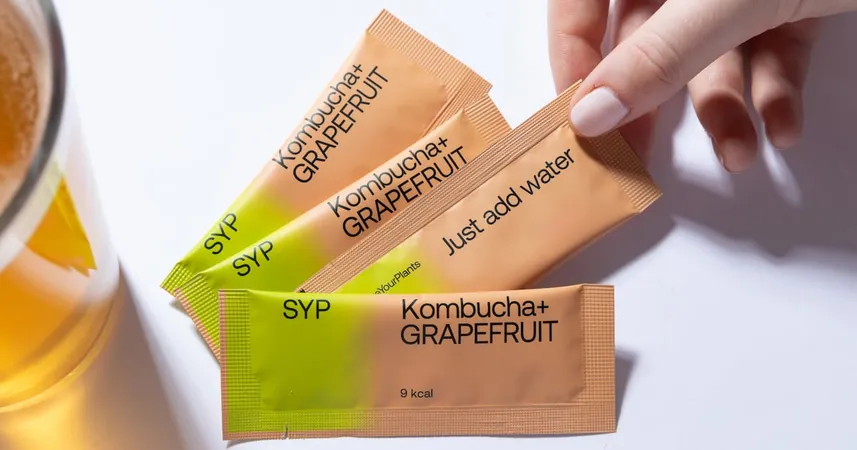
Chlorotonils: The Revolutionary Antibiotics Taking on Multidrug-Resistant Superbugs!
2025-04-15
Author: Yu
The Growing Crisis of Antibiotic Resistance
Antibiotic resistance has emerged as one of the most pressing global health challenges, threatening to render many of our current treatments ineffective. As bacteria evolve to evade the effects of commonly used antibiotics, there is an urgent need for innovative drugs that can combat these resistant strains.
A Breakthrough Discovery at HIPS
Enter the chlorotonils, a promising class of natural antibiotics discovered by researchers at the Helmholtz Institute for Pharmaceutical Research Saarland (HIPS). In a groundbreaking study published in *Cell Chemical Biology*, scientists have unveiled how these remarkable compounds can tackle antibiotic resistance head-on.
Targeting Bacteria Like Never Before
Chlorotonils stand out due to their unique dual-action mechanism. Rather than focusing on a single target, these molecules simultaneously disrupt the bacterial cell membrane and inhibit protein production. This dual assault makes it much harder for bacteria to develop resistance.
How Chlorotonils Work Their Magic
Under the leadership of Dr. Jennifer Herrmann and Prof. Rolf Müller, researchers demonstrated that chlorotonils latch onto the lipids in bacterial membranes. This destabilization allows potassium ions to leak uncontrollably, throwing the cell into chaos—disrupting essential functions and ultimately leading to cell death.
Dr. Felix Deschner, a leading researcher, shares his insights: "When chlorotonils attach to the cell membrane, it results in a rapid loss of potassium ions. This change disrupts the electrical balance of the membrane, causing a cascade of failures within the cell."
A Game Changer in Antibiotic Development
What's more, these antibiotics represent a rarely seen mechanism of action, which shields them from bacterial defense strategies. Unlike traditional antibiotics that target specific enzymes—which bacteria can easily adapt to—chlorotonils affect lipids, making it challenging for bacteria to form resistance.
Future Prospects and Applications
The implications of this discovery are revolutionary. Chlorotonils not only show incredible efficacy against notorious hospital pathogens like *Staphylococcus aureus* and *Enterococcus faecium*, but they also hold the potential to tackle the malaria pathogen, *Plasmodium falciparum*.
Currently, researchers are focused on enhancing the potency and safety of chlorotonils, with hopes of transforming them into a viable drug for malaria treatment under the GO-Bio initial program.
Unlocking New Frontiers in Antibiotic Research
Dr. Herrmann emphasizes the importance of these findings: "Chlorotonils open the door to a new class of antibiotics that can simultaneously target multiple bacterial structures. This not only makes them formidable against multidrug-resistant infections but also paves the way for future discoveries of similar agents with innovative mechanisms."
As the fight against antibiotic resistance escalates, the discovery of chlorotonils marks a significant stride in safeguarding our health and developing effective treatments that can withstand the challenges posed by superbugs.





 Brasil (PT)
Brasil (PT)
 Canada (EN)
Canada (EN)
 Chile (ES)
Chile (ES)
 Česko (CS)
Česko (CS)
 대한민국 (KO)
대한민국 (KO)
 España (ES)
España (ES)
 France (FR)
France (FR)
 Hong Kong (EN)
Hong Kong (EN)
 Italia (IT)
Italia (IT)
 日本 (JA)
日本 (JA)
 Magyarország (HU)
Magyarország (HU)
 Norge (NO)
Norge (NO)
 Polska (PL)
Polska (PL)
 Schweiz (DE)
Schweiz (DE)
 Singapore (EN)
Singapore (EN)
 Sverige (SV)
Sverige (SV)
 Suomi (FI)
Suomi (FI)
 Türkiye (TR)
Türkiye (TR)
 الإمارات العربية المتحدة (AR)
الإمارات العربية المتحدة (AR)